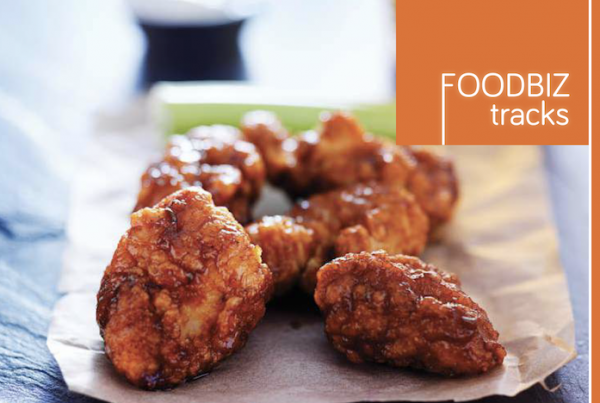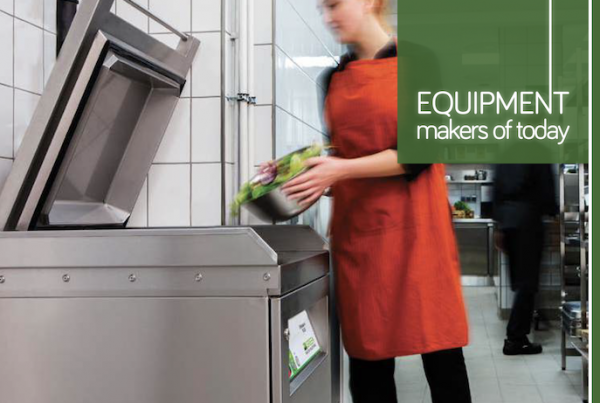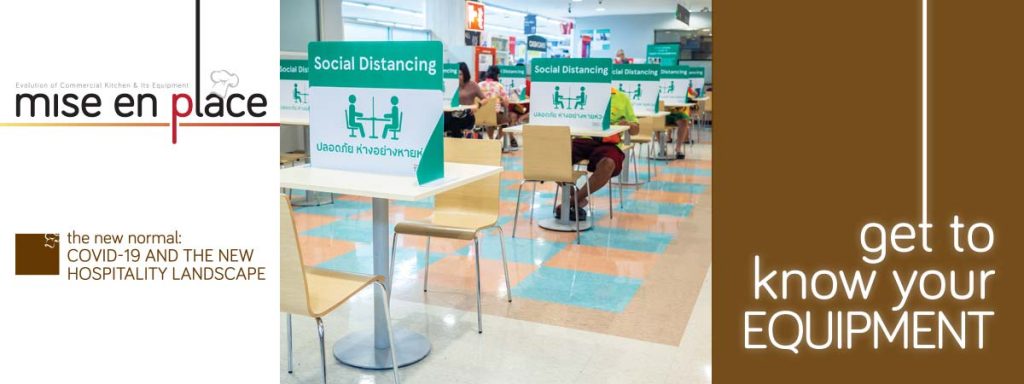 As a result of Covid-19, the foodservice industry has been operating intensely, churning strategies to adapt and cope during the pandemic. Now that we are preparing for the post-Covid era in Asia, or at the very least in Malaysia, a majority of restaurants, hotels, cafes, and businesses are anticipating changes, if not further changes, in operations – having anticipated financial impact nation-wide and worldwide. While many nations in Asia have looked into relief aid solutions to keep industries such as the foodservice and hospitality industry afloat, not many can hold on for long. In response, the foodservice and hospitality industry players have been adjusting their operational strategies urgently to increase agility, while maintaining business continuity, particularly in supply chain and procurement.
As a result of Covid-19, the foodservice industry has been operating intensely, churning strategies to adapt and cope during the pandemic. Now that we are preparing for the post-Covid era in Asia, or at the very least in Malaysia, a majority of restaurants, hotels, cafes, and businesses are anticipating changes, if not further changes, in operations – having anticipated financial impact nation-wide and worldwide. While many nations in Asia have looked into relief aid solutions to keep industries such as the foodservice and hospitality industry afloat, not many can hold on for long. In response, the foodservice and hospitality industry players have been adjusting their operational strategies urgently to increase agility, while maintaining business continuity, particularly in supply chain and procurement.

Sharing the same concern are equipment manufacturers in the foodservice industry, more so because the demands and habits in dining out have changed. The types of products, locations of the manufacturing plants, and the demographics of the employee base have all a major role in determining a manufacturing operational status. While factors such as this might have felt like steering into a “storm” for the foodservice industry, let’s first look into some of the changes that have taken place in the dining habits as a result of the blow.
Changes in Expectations
First of all, the expectation of a restaurant service has changed. Friendly service that has been central to the whole dining out experience is no longer fully appreciated as smiling waiters and waitresses will be replaced with staffs in masks which hides half of their face. Not only the dining-out experience is stripped off to some effect, the restaurant dining experience is also set to transition into the era of social distancing where some limitations will be introduced. These limitations will most particularly include a maximum number of diners to be allowed into the F&B premise and per table, as well as on keeping a safe distance between tables.
Changes in Business Model
With the expectation of pivoting from a “dining out” business model to an online ordering platform, comes elements of change arise in a restaurant business model. For some restaurants, that would mean tweaking and streamlining menus in order to offer food offerings that are conducive to travel well. From a cost perspective, an average commission of 30 to 35 percent to food delivery platforms should be included. While this means the price under the new business model would only cover the cost of goods sold, it is important to streamline the variety of foods sold so focus can be given to the foods that are being sold via online ordering platforms such as GrabFood or Food Panda.
For bigger restaurant chains, the concerns are equally big. More restaurants operating on the big scale are adopting business models with radical takeouts and bespoke services such as private catering options and delivery. While some restaurant groups are investing in technology and e-commerce to cater to the takeout model, some choose to look into the possibility of retail marketing where its signature dishes will be packaged and sold in the retail market. At this point, multitasking is important as marketing and public relations strategies will be put into place while the outlet management goes through the necessary SOPs. Simultaneously, the back-ofhouse (BOH) kitchen will undergo technological and technical trainings to get accustomed to GrabFood orders and other online orders.
 Changes in Demand & Supply
Changes in Demand & Supply
Another challenge is the scarcity of supplies leading to increase in the prices of premium and imported ingredients, which will compel big restaurant chains to change their menu choices and conceptual direction. Plus, the big question remains – Will things return to normal in the immediate future? For some, it certainly looks like six to nine months before the foodservice industry returns to pre-MCO days. The main reason for the concern is the loss of consumer confidence, which has been a major challenge in terms of demand for most businesses in the foodservice and hospitality industry. Adding to the problem is the demand for contactless services which will only cause the spiralling down of employment.
With these changes, arise…
As the foodservice industry continues to deal with the crisis and moves toward recovery, one thing is certain for F&B operators and food equipment manufacturers – a plan needs to be put in place to begin the process of meeting the new demands and the new normal. We know from our recent discussions with some known equipment manufacturers in the foodservice industry that leadership starts with identifying the needs of operations – a playbook that should be proficiently managed to guide all activities dedicated to bringing back that normalcy to the industry in a time such as this.
New Formats of Kitchen
 Covid-19 certainly brings to our attention the rise of new formats of commercial kitchen. A new format of kitchen that has found its necessity for countless businesses worldwide in the present time is ghost kitchens. Even if the “mysterious” kitchen concept wasn’t investing in a shared space or cloud kitchen per se, coronavirus forced operators to turn their typical venues into delivery- and takeout-focused spaces that mirrored the necessity of change. But that tells us something – as takeaways and delivery pick-up, operators need to adapt their processes and service speed to cope with the rising demand.
Covid-19 certainly brings to our attention the rise of new formats of commercial kitchen. A new format of kitchen that has found its necessity for countless businesses worldwide in the present time is ghost kitchens. Even if the “mysterious” kitchen concept wasn’t investing in a shared space or cloud kitchen per se, coronavirus forced operators to turn their typical venues into delivery- and takeout-focused spaces that mirrored the necessity of change. But that tells us something – as takeaways and delivery pick-up, operators need to adapt their processes and service speed to cope with the rising demand.
Operating a successful takeaway or delivery business requires a very different approach rather than treating it as an extension of the dine-in business. Such change in concept requires the ability to cope with the speed and quick turnover for takeaway and delivery orders, a place where high-speed cooking becomes very relevant. With equipment such as Merrychef high speed ovens and Lincoln Impinger® Conveyor ovens, cooking can be done even before the order comes in. Merrychef’s high-speed ovens allow shorter cook times, higher energy efficiency, and ventless operations with touchscreen technology. The oven makes possible the capacity to cook large volumes of high quality food especially for busy kitchens.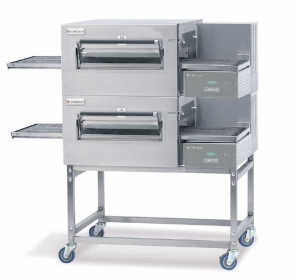
For restaurant businesses that are stepping into this new era, conveyor ovens can be similarly helpful. The Lincoln Impinger® Conveyor ovens enable rapid heating, cooking, baking, and crisping of food through the air impingement technology. The technology is known for eliminating operator error and providing quick, consistent results for F&B establishments. For more information on how these series of ovens can cater to the capacity and speed of your kitchen, perhaps as a way to accommodate a new and faster format of kitchen, you may visit www.welbiltasia.com/.
The Reopening of Restaurants… and The Importance of Ventilation
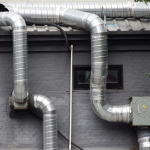 Most markets across the globe came to a halt during Covid-19 while some slowed down due to the pandemic. With tourism and hospitality being one of the industries that were gravely affected, the reopening of the industry should certainly accelerate the hopes of business owners. However, one of the biggest hurdles to its reopening could be ventilation. According to the scientific journal The Lancet Respiratory Medicine, the small coronavirus droplets that potentially contain virus particles can float in the air in a particular room or area for many minutes. Contributing to the containment is poor ventilation. UvA physicists and medical researchers, therefore, have suggested premises to take note of appropriate ventilation and encouraged good ventilation in public spaces to curb the spread of the virus.
Most markets across the globe came to a halt during Covid-19 while some slowed down due to the pandemic. With tourism and hospitality being one of the industries that were gravely affected, the reopening of the industry should certainly accelerate the hopes of business owners. However, one of the biggest hurdles to its reopening could be ventilation. According to the scientific journal The Lancet Respiratory Medicine, the small coronavirus droplets that potentially contain virus particles can float in the air in a particular room or area for many minutes. Contributing to the containment is poor ventilation. UvA physicists and medical researchers, therefore, have suggested premises to take note of appropriate ventilation and encouraged good ventilation in public spaces to curb the spread of the virus.
In fact, physical distancing in F&B establishments may not entirely help the prevention of Covid-19 as the spaces can still accommodate the spreading of virus if not ventilated properly. When the virus droplets linger in the air for a long time, even proximity tracing via smartphone apps will be an less effective precaution. It is vital, therefore, to consider the recommendations of researchers and healthcare authorities ensure adequate ventilation upon the reopening of F&B premises.
According to Halton, it definitely seems like it will take a while for people to start travelling again, especially internationally. But that means consumers will begin to go to local restaurants, which means local restaurants will recover first. The recognition that this virus is air-borne and potentially can be carried over a ventilation system will change perception of HVAC (heating ventilation and air conditioning) systems. Indoor Environmental Quality (IEQ) will be viewed as an important factor with emphasis on ventilation systems and how well they can reduce risk of infection transmission. At this point, the biggest hurdle for all business owners will be ways to bring customers’s confidence back. Yet, as an equipment manufacturer in the foodservice and hospitality industry, Halton’s goal remains the same – help F&B business owners to create a safer environment for guests and employees within premises.
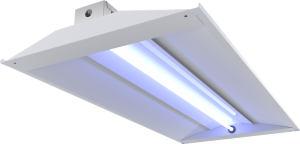 Fortunately, Halton has anti-viral solutions that will help make guests and employees safer by reducing the risk of virus spread. Having done extensive research to establish criteria for ventilation design to mitigate airborne transmission of infectious disease, Halton Health Segment together with Halton Foodservice have decided to deploy Halton SafeGuard UVGI (Ultraviolet Germicidal Irradiation) Solutions to resurrect the foodservice and hospitality industry. With UVGI Return Air Grill System, UVGI Overhead Light and UVGI Stand-alone Mobile Filter, ventilation should be less of a hurdle for businesses that want to recover during a time such as this.
Fortunately, Halton has anti-viral solutions that will help make guests and employees safer by reducing the risk of virus spread. Having done extensive research to establish criteria for ventilation design to mitigate airborne transmission of infectious disease, Halton Health Segment together with Halton Foodservice have decided to deploy Halton SafeGuard UVGI (Ultraviolet Germicidal Irradiation) Solutions to resurrect the foodservice and hospitality industry. With UVGI Return Air Grill System, UVGI Overhead Light and UVGI Stand-alone Mobile Filter, ventilation should be less of a hurdle for businesses that want to recover during a time such as this.
For more information on its system capabilities, please visit www.uvrestaurantsolutions.com/uvgi/.
The Importance of Hand Hygiene.. and The Role of Faucets
 As we continue to talk about hygiene, let’s also talk about how Covid-19 has sparked a public focus on hand hygiene like never before. As businesses begin to reopen, providing clean and healthy environments to keep customers safe are becoming more important than ever. For F&B establishments, this starts with implementing more handwashing stations and switching to hands-free washing, which can certainly make a big difference in helping protect public health.
As we continue to talk about hygiene, let’s also talk about how Covid-19 has sparked a public focus on hand hygiene like never before. As businesses begin to reopen, providing clean and healthy environments to keep customers safe are becoming more important than ever. For F&B establishments, this starts with implementing more handwashing stations and switching to hands-free washing, which can certainly make a big difference in helping protect public health.
In fact, hand hygiene has created some of the biggest waves of change in the foodservice and hospitality industry. The availability of hand stations, the distance between people during dishwashing, and the cleanliness of the restaurant are some of the factors customers evaluate as they dine in. The awareness of handwashing in itself has become the blessing in disguise for those who have been too “comfortable” with their handwashing practice for the longest time. That means operators need to be ready to deal with all these expectations, and move towards friendlier faucet solutions.
For T&S, this is not a surprise. A huge spike in demand for sensor faucets is already seen in the industry due to the reduced risk of spreading of germs through touchless activation, and a big cut in the amount of water per hand wash wasted and electricity consumed (reducing water means using less hot water; less energy invested to heat water). With the incre
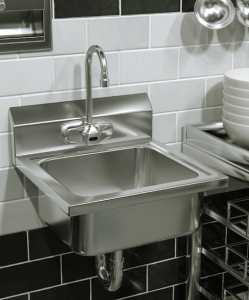
asing focus on hand hygiene in the wake of the coronavirus pandemic, there’s been an intense interest in sensor faucets for nearly every kind of handwashing situation out there. By removing potentially contaminated touchpoints, sensor faucets help boost hygiene and protect public health at a critical time.
Hands-free sensor faucets have been on a gradual rise for years as operators realised their benefits in both hygiene and water conservation. With the Covid-19 pandemic taking things by storm, the rise has only been amplified. Being able to wash hands without touching faucet handles is really significant right now and T&S is presently, gladly helping provide these critical safety products to operators all over the world.
For more information on T&S’s sensor faucets, please visit www.tsbrass.com.
Food Delivery… and The Need for Food Holding
As food delivery becomes the “new normal”, concerns on food protection and food safety should become the new normal too. Often overlooked in the food delivery process, food holding plays an important role in making sure food is safe for consumption. Separating raw from ready-to-eat foods, using containers that protect the food from insects or rodents, and holding temperature should be protection measures that should be in place before a restaurant business considers setting up an online food order service.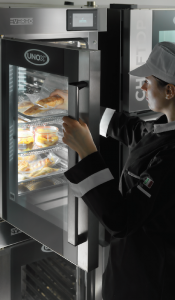
But it’s not only that. When considering a food delivery as the new business model, foods need to be stored properly prior to being delivered, with further consideration of quality, speed and efficiency. That brings us to the primal question – Is it even possible to combine the quality and safety of slow food with the efficiency of fast service for a food delivery model? Is it possible to maintain foods at their original taste and appearance or perhaps, preserve them while avoiding overcooking? Can food be preserved at the temperature you want to serve it?
 With UNOX ’s Hot Fridge, Evereo, it is likely possible. With Evereo’s innovative service-temperature preservation technology, food can be served at the temperature you want it to be served. Evereo allows the holding of trays of cooked food that have not been vacuum sealed for more than 2 hours, in contrast to holding cabinets of traditional capacity. With the technology’s precise atmosphere and temperature control, restaurants can worry less about their menu offerings as food can be held in closed containers for up to 8 hours with quality results. Evereo can be used as a reliable holding cabinet to obtain longer preservation times or taking full advantage of the food preservation at service temperature technology, keeping restaurant dishes ready for days. With features such as “Superholding” and other forms of flexibility, stepping into the new era of commercial kitchen definitely seems hopeful.
With UNOX ’s Hot Fridge, Evereo, it is likely possible. With Evereo’s innovative service-temperature preservation technology, food can be served at the temperature you want it to be served. Evereo allows the holding of trays of cooked food that have not been vacuum sealed for more than 2 hours, in contrast to holding cabinets of traditional capacity. With the technology’s precise atmosphere and temperature control, restaurants can worry less about their menu offerings as food can be held in closed containers for up to 8 hours with quality results. Evereo can be used as a reliable holding cabinet to obtain longer preservation times or taking full advantage of the food preservation at service temperature technology, keeping restaurant dishes ready for days. With features such as “Superholding” and other forms of flexibility, stepping into the new era of commercial kitchen definitely seems hopeful.
For more information on Evereo, please visit http://www.evereo.com/.
Concerns of Hygiene…and The Need for Dishwashing.
 We can’t talk about the “new normal” without talking about hygiene. Hand sanitisers, surface sanitation – you name it. Rebuilding the foodservice and hospitality industry will take some time and it will take more time if hygiene and sanitation are neglected. An abstract yet crucial part of this is creating a space of assurance where customers and employees can be safe.
We can’t talk about the “new normal” without talking about hygiene. Hand sanitisers, surface sanitation – you name it. Rebuilding the foodservice and hospitality industry will take some time and it will take more time if hygiene and sanitation are neglected. An abstract yet crucial part of this is creating a space of assurance where customers and employees can be safe.
Yet, there are multiple factors involved in making this happen. For equipment makers in the industry such as MEIKO, expectations towards hygiene and sanitation, in particular, have seen drastic changes especially in the demand of products. As a part of the cleaning and disinfection realm of the industry, there is now a different understanding of what customers are looking for in cleaning solutions. Previously, cleaning and disinfection were optional or rather “good to have”. Now, it is a “MUST have”. For MEIKO, the standards have increased. Ware washing machines are slowly moving away from the “just wash” trend towards a “hygienic disinfecting washing” result. But as one of the leaders in the industry, MEIKO sees this as the way to run the race. The company has responded to Covid-19 by certifying all of its ware washing solutions on the effective inactivation of coronaviruses.
 One of the equipment that accommodates such change is MEIKO’s M-iClean HM. Suitable for large washware and confined workspaces, the M-iClean HM hood type dishwashing machine offers higher wash cycles while saving up to 30 minutes of wash everyday. The machine also offers an automatic hood system, automatic rack detection, and easy human-machine communication using an innovative signal concept and eye-level operating panel. Not only do these features reduce the strain of employees, M-iClean HM also helps the restaurant service to implement a robust hygienic practice in place with sufficient confidence of preventing the spread of Covid-19, effectively and efficiently.
One of the equipment that accommodates such change is MEIKO’s M-iClean HM. Suitable for large washware and confined workspaces, the M-iClean HM hood type dishwashing machine offers higher wash cycles while saving up to 30 minutes of wash everyday. The machine also offers an automatic hood system, automatic rack detection, and easy human-machine communication using an innovative signal concept and eye-level operating panel. Not only do these features reduce the strain of employees, M-iClean HM also helps the restaurant service to implement a robust hygienic practice in place with sufficient confidence of preventing the spread of Covid-19, effectively and efficiently.
For more information, please visit https://www.meiko-asia.com/en/products/warewashing/hood-type-dishwashing-machines/
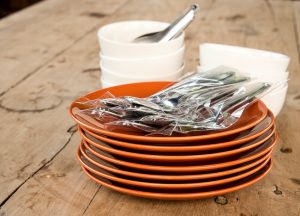
The potential possibility that every foodservice serve sanitised and packed for service.
We have all had to accept and adapt to the changes that this new world has brought, and these are just a few steps that can be taken to ensure your business is more agile and resilient to an ever-changing environment. For business owners in the foodservice and hospitality industry, the lessons we are learning together around the world are evidence of the clear need for a transition to a more efficient and effective business environment, by using the right technology and equipment.
Source: The Star, QDA, equipment brands’ websites







